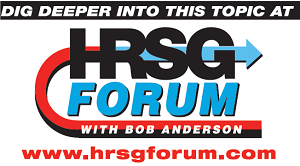It’s important to have a comprehensive checklist of what to inspect on your HRSG, and how, before conducting a condition assessment of your equipment for plant management and/or due diligence purposes. Your checklist may have scores of items to review but it’s impossible to identify everything to look at—usually because your depth of knowledge and experience is lacking in one or more areas for a particular boiler design.
Bob Anderson was in the middle of noting “hot topics” for the open discussion sessions at the upcoming HRSG Forum with Bob Anderson at the Hilton Orlando, July 22-25, when the editors called the other day. We asked him to identify a couple of things he believes plant personnel might forget to check during a walk-down.
Ensuring proper lubrication of sliding feet found under the column supports on the hot end of some HRSGs was the first thing he mentioned. He explained that it’s important for these plates to move freely as the boiler expands and contracts during startup and shutdown to avoid stressing structural steel unnecessarily. Another tip Anderson offered was to check that the washers under the hold-down nuts are free to rotate. He sometimes finds the nuts tight, as they should be for non-moving columns, thereby preventing sliding.
Another simple check that owners often forget, Anderson continued, is the proper routing of the discharge pipe from the atmospheric vent at the top of a Consolidated safety valve body and/or the proper routing of the drain at the bottom of the valve. It’s important that the vent not point at the walkway, to protect personnel; also, that it not point upward, allowing the collection of rainwater. Important, too, is that the vent and the drain not be tied together, as that would affect the valve’s blowdown setting. Finally, be sure the shipping plug has been removed from the vent hole.


